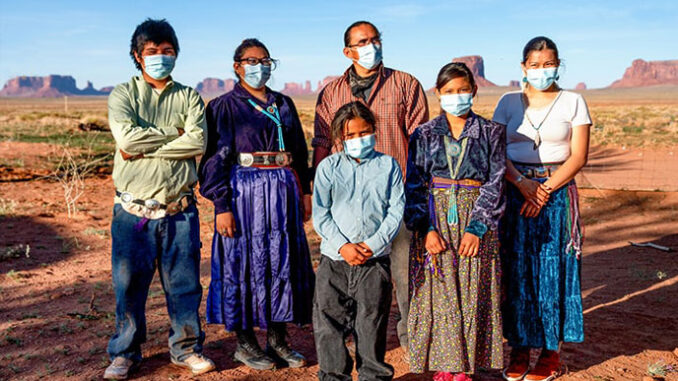
Kaleb Crump Data News Weekly Contributor
To date, the epicenter of the COVID-19 spread in Louisiana has been metropolitan areas like New Orleans. However, experts note that Indigenous, Latino, and rural Black communities across the state remain overlooked. The Centers for Disease Control and Prevention found that in 23 states, Native American communities had an infection rate three times higher than White Americans. Black and Latino-Americans were also twice as likely to contract and die from the virus.
Native Americans have also been disproportionately affected by the virus. At the height of the pandemic, the Navajo Nation had surpassed New York State for the highest infection rate in the U.S. Beyond the infection and death rates, communities of color are almost twice as likely to report job loss and economic hardship due to the pandemic, compared to White communities.
“When we talk about rural communities, this cuts across the various segments of the population in terms of race and ethnicity and all the social demographics, “said Dr. Daniel Sarpong, the Endowed Chair and Director for the Center for Minority Health and Health Disparities Research and Education in Xavier University’s College of Pharmacy.
“We don’t want people to still get caught up in the Black and White comparisons and to realize that it’s affecting all segments of the population,” said Sarpong who shared his expertise in a panel discussion on Oct. 7, 2020 as part of an ongoing COVID-19 series titled “The Truth Exposed.”
The panelists comprised of Dr. Irene Ane Anyangwe of the School of Science of Navajo Technical University, Ethel Branch of the Navajo & Hopi Families COVID-19 Relief Fund, Amy Elizondo of the National Rural Health Association, Dr. Estaban Gershanik of Children’s Hospital New Orleans, and Dr. Yvens Laborde of Ochsner Health. The experts sought to focus attention broadly on how Latino, Native, and rural communities shared commonalities with African American communities in terms of the impact of the pandemic on health and quality of life.
“These are issues that we’ve been seeing in both the Indigenous, Latinx, and rural communities for a very long time,” Sarpong said. “If anything, what this does is expose those underlying truths of where there is access to care,” he added.
What Latino, Native, and rural communities share with Black communities is the distance to medical care, under coverage in health plans, and lack of services.
“Pandemics, they take off that band aid to expose the truth underneath the structural issues around these most vulnerable populations that have these various dynamics that correlate with the social determinants of health and other components,” said Dr. Esteban Gershanik of Children’s Hospital.
In addition to access to health care, Latino, Indigenous, and rural communities also experience food insecurities, lack of public infrastructure, and lack of quality education. Additionally, researchers aren’t studying these communities sufficiently, resulting in less data that documents the impact of the pandemic on these groups, the panelists said.
“If we can align policies amongst all of these shared communities with preexisting conditions, I think we could push this forward with momentum and ride the wave of where there’s a call to action that I think it’s probable and I hope we seize upon instead of feeling this is one that’s loud in voice but not in action,” Gershanik said.
There is no coincidence that the pandemic also triggered renewed calls for social justice in communities of color, the panelists added.
“There’s a forgotten aim that’s in essence at the center of all the difficulties we’re struggling with. That forgotten aim is equity,” said Dr. Yvens Laborde with Oschner Health. Laborde echoed Dr. Martin Luther King Jr.’s words on how all forms in inequality work together to result in forms of injustice. Laborde noted that the pandemic has helped society to see how health and health care fits into overall forms of injustice.
“There has to be equity in all aspects of the society and unless we address that we’ll never actually achieve a more ultimate goal,” Laborde said.
Dr. Irene Ane Anyangwe, School of Science, Navajo Technical University
Ethel Branch, Navajo & Hopi Families COVID-19 Relief Fund.
Amy Elizondo, M.P.H. National Rural Health Association.
Dr. Esteban Gershanik, M.D., M.P.H., M.M.Sc., F.A.A.P., F.H.M. of Children’s Hospital N.O., Brigham and Women’s Hospital, Dana Farber Cancer Institute Harvard Medical School, LSU and Tulane School of Medicine,
Dr. Yvens Laborde, M.D. Ochsner Health University of Queensland-Ochsner Clinical School
Dr. Daniel Sarpong, Endowed Chair, College of Pharmacy, Xavier University.
The forum was moderated by Dr. David Robinson-Morris, the director of the Center for Equity, Justice and the Human Spirit at Xavier University, and Tynesia Fields, the community engagement and outreach coordinator for the Center for Minority Health and Health Disparities Research and Education at Xavier University.
Recommended For You.



Be the first to comment